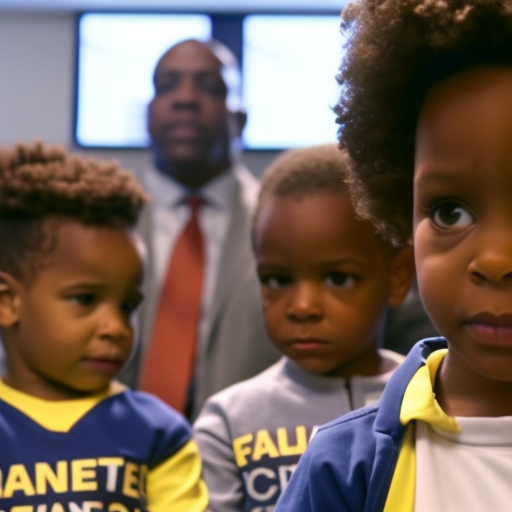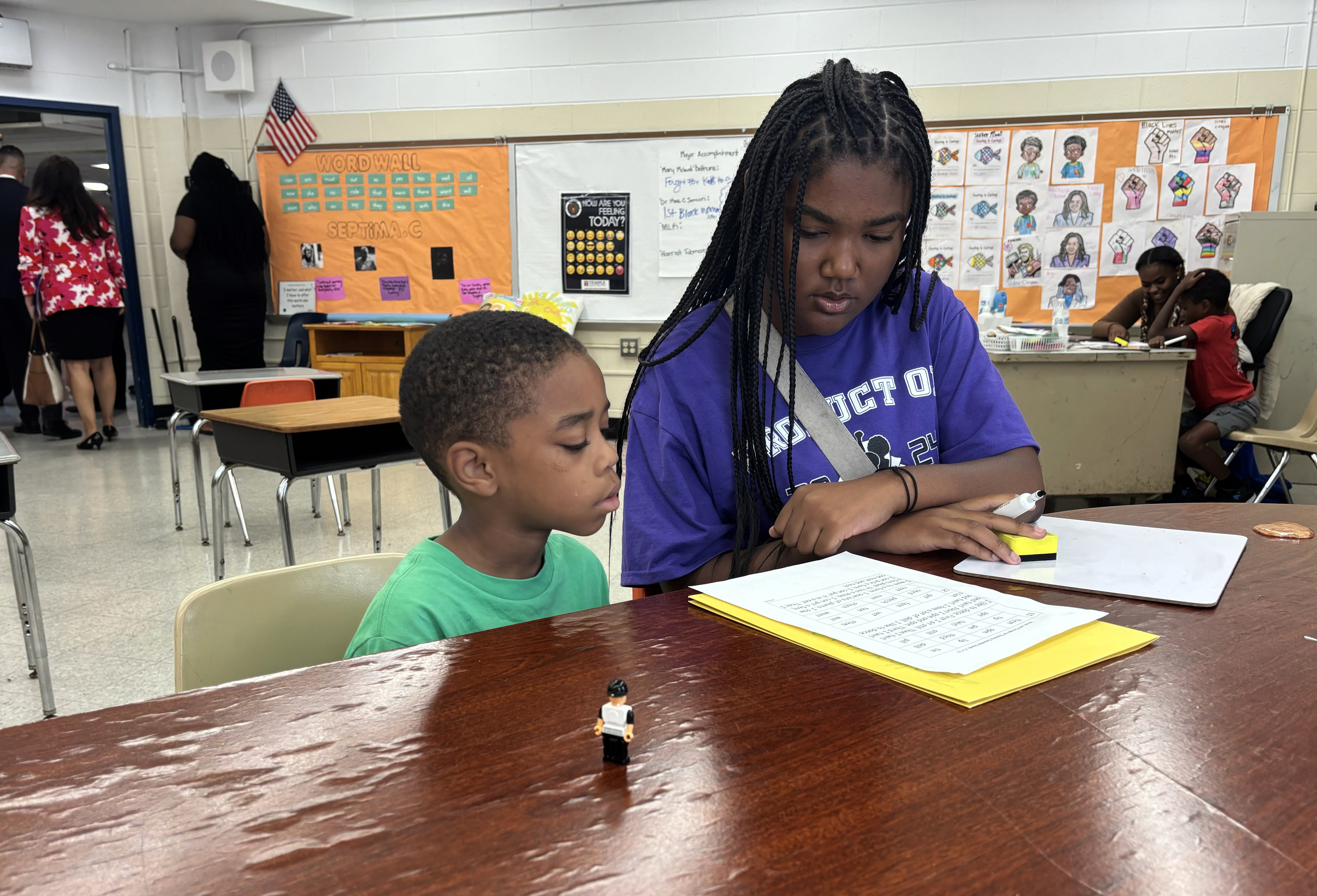
Sustainable Development Goals (SDGs) in Maryland’s Plans to Expand Prekindergarten Programs

Introduction
Rene Averitt-Sanzone, executive director with The Parents’ Place of Maryland, is one of many early childhood advocates who support Maryland’s plans to dramatically expand prekindergarten programs during a 10-year education reform effort.
The Blueprint for Maryland’s Future sets early childhood opportunities as its first pillar, or priority. That includes universal access to prekindergarten for 3- and 4-year-old children.
Inclusive Early Childhood Curricula
As prekindergarten opportunities expand, school systems must also ensure early childhood curricula are more inclusive for children with disabilities, Averitt-Sanzone said.
Her goal for success: “Really finding a way to make a place for our little ones with disabilities in the pre-k classrooms,” she said. “We can’t do any of that stuff if we are not supporting the teachers and child care providers. We operate from a place of collaboration and partnership.”
Planned Reforms
Other planned reforms in early childhood education include working with families to make them aware of expanded access. And teaching assistants will be required to earn an associate’s degree or child development associate credential by the 2027-28 school year.
The expanded pre-K structure is proposed as a mixed-delivery system, where public schools and private child care providers both serve young children.
Challenges and Considerations
Bill Hudson, executive director for Family Child Care Alliance of Maryland, said there remain challenges. For example, if more children ages 3 and 4 attend prekindergarten in a public school, that could decrease enrollment at child care centers and family child care providers.
The state has previously relied heavily on a network of private child care providers. Maryland has about 4,000 family child care providers that can enroll up to eight children, Hudson said. In comparison, neighboring Pennsylvania had about 1,300 last year and there were around 1,400 in Virginia.
“The area of Maryland is about a quarter of Pennsylvania. Lots of families depend on family child care [in Maryland],” he said. “I’m a fan of the Blueprint in what it’s trying to do to make high quality pre-k done well in family child care…but [in order] to get to where we are to where we collectively want to be, there’s a lot of work to do.”
Blueprint Accountability and Implementation Board
The state’s Blueprint Accountability and Implementation Board is tasked with reviewing the education reform plans from all 24 local school systems across the state. School officials submitted their first plans in March, which outlined work that began last school year and in preparation for the 2023-24 school year.
The board could start approving local reform plans next month.
Operational Changes to Support Pre-K Expansion
The initial plans include answers to more than two dozen questions and statements about how local school systems would improve learning for the younger children, including the operational changes that will be necessary at local school buildings.
To give a flavor of the scope of work that school systems are undertaking to facilitate such a broad expansion of early childhood education, we’ve compiled all or part of the responses of each school district to one question in the planning report:
Allegany
- Operationalizing the expansion of Pre-K will remain a focus in Allegany County. In FY23, the district supported expansion of full-day Pre-K into middle and elementary schools by dedicating space, altering staff schedules, modifying transportation routes, and adding administrative assignments. A Pre-K center, namely the Westmar Early Learning Center (WELC), in the western region of Allegany County at Westmar Middle School, was created. That site was chosen due to underutilization of space in the school building. Pre-K staff including teachers and instructional assistants were reassigned to the WELC. Additionally, a full-time Assistant Principal was assigned to the building to support the new program. Although implementing new full-day Pre-K programs in several of the district’s elementary schools may require long-term construction plans for new classrooms, expansion into schools with existing space will take priority. In the future as needed, ACPS will collaborate with community agencies to utilize any available, appropriate space to establish Pre-K sites. Additionally, modifying and increasing transportation resources to accommodate access to regionally placed programs within the county will be considered.
Anne Arundel
- AACPS has converted 4-year-old Pre-Kindergarten programs to full-day in 61 schools. This year we launched 3-year-old Pre-Kindergarten in eight schools. The multi-year approach has allowed AACPS to meet the Blueprint requirements of one certified teacher and one qualified Teacher assistant/Paraprofessional in each classroom. As we continue to expand Pre-Kindergarten opportunities to eligible families, we will adjust operational needs as necessary.
- Planning for Pre-Kindergarten Spaces: AACPS has surveyed AACPS buildings to identify educationally sufficient space for potential Pre-Kindergarten classroom expansion and we are exploring non-traditional options such as space in middle and high schools and commercial real estate locations for possible expansion. The pre-Kindergarten expansion was also a consideration in our most recent redistricting plan. Once a redistricting plan is approved, we will better project future location sites. Funding for future Pre-Kindergarten expansion will require local and state funding sources. A Kindergarten and Pre-Kindergarten addition fund currently exists for expanding Pre-Kindergarten at our school facilities, but this fund will most likely not meet our future demand needs. We must consider building Pre-Kindergarten centers, leasing, and retrofitting leased facilities, and expanding our capacity in other ways to meet all the Blueprint requirements related to space and expansion of Pre-Kindergarten.
Baltimore City
SDGs, Targets, and Indicators
SDGs Addressed or Connected to the Issues Highlighted in the Article:
- SDG 4: Quality Education
- SDG 5: Gender Equality
- SDG 8: Decent Work and Economic Growth
- SDG 10: Reduced Inequalities
- SDG 17: Partnerships for the Goals
Specific Targets Under Those SDGs Based on the Article’s Content:
- SDG 4.2: By 2030, ensure that all girls and boys have access to quality early childhood development, care, and pre-primary education so that they are ready for primary education.
- SDG 4.5: By 2030, eliminate gender disparities in education and ensure equal access to all levels of education and vocational training for the vulnerable, including persons with disabilities.
- SDG 4.a: Build and upgrade education facilities that are child, disability, and gender-sensitive and provide safe, non-violent, inclusive, and effective learning environments for all.
- SDG 5.4: Recognize and value unpaid care and domestic work through the provision of public services, infrastructure, and social protection policies and the promotion of shared responsibility within the household and the family as nationally appropriate.
- SDG 8.5: By 2030, achieve full and productive employment and decent work for all women and men, including for young people and persons with disabilities, and equal pay for work of equal value.
- SDG 10.2: By 2030, empower and promote the social, economic, and political inclusion of all, irrespective of age, sex, disability, race, ethnicity, origin, religion, or economic or other status.
- SDG 17.17: Encourage and promote effective public, public-private, and civil society partnerships, building on the experience and resourcing strategies of partnerships.
Indicators Mentioned or Implied in the Article:
- Indicator 4.2.1: Proportion of children under 5 years of age who are developmentally on track in health, learning, and psychosocial well-being, by sex.
- Indicator 4.5.1: Parity indices (female/male, rural/urban, bottom/top wealth quintile, and others such as disability status, indigenous peoples, and conflict-affected, as data become available) for all education indicators on access, participation, and completion.
- Indicator 4.a.1: Proportion of schools with access to electricity, by type of school.
- Indicator 5.4.1: Proportion of time spent on unpaid domestic and care work, by sex, age, and location.
- Indicator 8.5.2: Unemployment rate, by sex, age, and persons with disabilities.
- Indicator 10.2.1: Proportion of people living below 50 percent of median income, by sex, age, and persons with disabilities.
- Indicator 17.17.1: Amount of United States dollars committed to public-private partnerships.
Table: SDGs, Targets, and Indicators
| SDGs | Targets | Indicators |
|---|---|---|
| SDG 4: Quality Education | 4.2: By 2030, ensure that all girls and boys have access to quality early childhood development, care, and pre-primary education so that they are ready for primary education. | 4.2.1: Proportion of children under 5 years of age who are developmentally on track in health, learning, and psychosocial well-being, by sex. |
| SDG 5: Gender Equality | 5.4: Recognize and value unpaid care and domestic work through the provision of public services, infrastructure, and social protection policies and the promotion of shared responsibility within the household and the family as nationally appropriate. | 5.4.1: Proportion of time spent on unpaid domestic and care work, by sex, age, and location. |
| 5.4: Eliminate gender disparities in education and ensure equal access to all levels of education and vocational training for the vulnerable, including persons with disabilities. | 4.5.1: Parity indices (female/male, rural/urban, bottom/top wealth quintile, and others such as disability status, indigenous peoples, and conflict-affected, as data become available) for all education indicators on access, participation, and completion. | |
| SDG 8: Decent Work and Economic Growth | 8.5: By 2030, achieve full and productive employment and decent work for all women and men, including for young people and persons with disabilities, and equal pay for work of equal value. | 8.5.2: Unemployment rate, by sex, age, and persons with disabilities. |
| SDG 10: Reduced Inequalities | 10.2: By 2030, empower and promote the social, economic, and political inclusion of all, irrespective of age, sex, disability, race, ethnicity, origin, religion, or economic or other status. | 10.2.1: Proportion of people living below 50 percent of median income, by sex, age, and persons with disabilities. |
| SDG 17: Partnerships for the Goals | 17.17: Encourage and promote effective public, public-private, and civil society partnerships, building on the experience and resourcing strategies of partnerships. | 17.17.1: Amount of United States dollars committed to public-private partnerships. |
Behold! This splendid article springs forth from the wellspring of knowledge, shaped by a wondrous proprietary AI technology that delved into a vast ocean of data, illuminating the path towards the Sustainable Development Goals. Remember that all rights are reserved by SDG Investors LLC, empowering us to champion progress together.
Source: marylandmatters.org

Join us, as fellow seekers of change, on a transformative journey at https://sdgtalks.ai/welcome, where you can become a member and actively contribute to shaping a brighter future.






